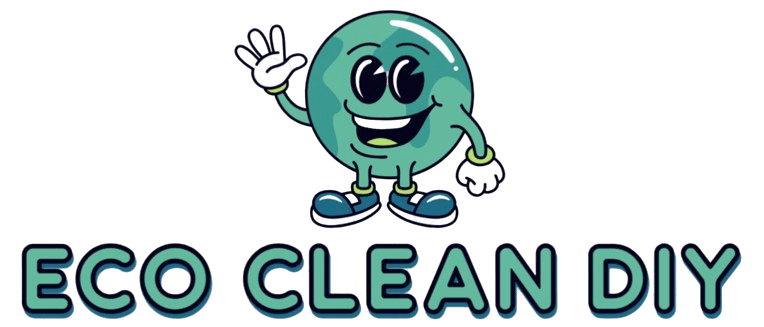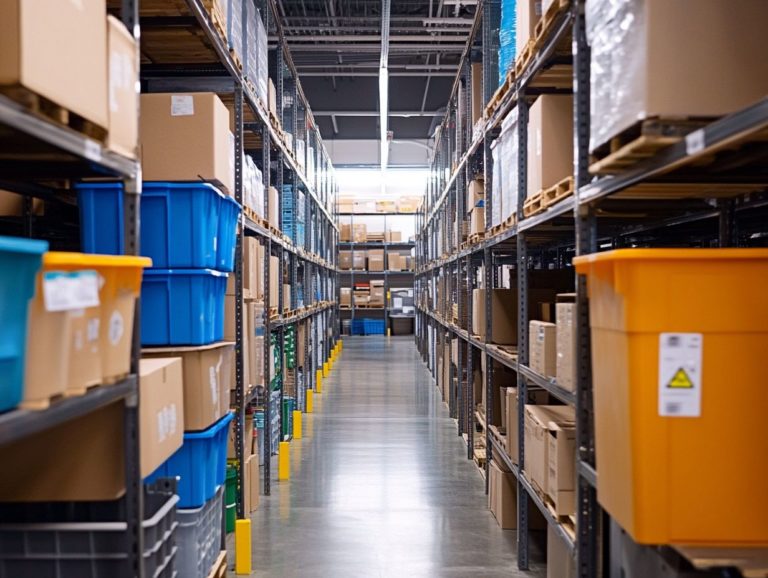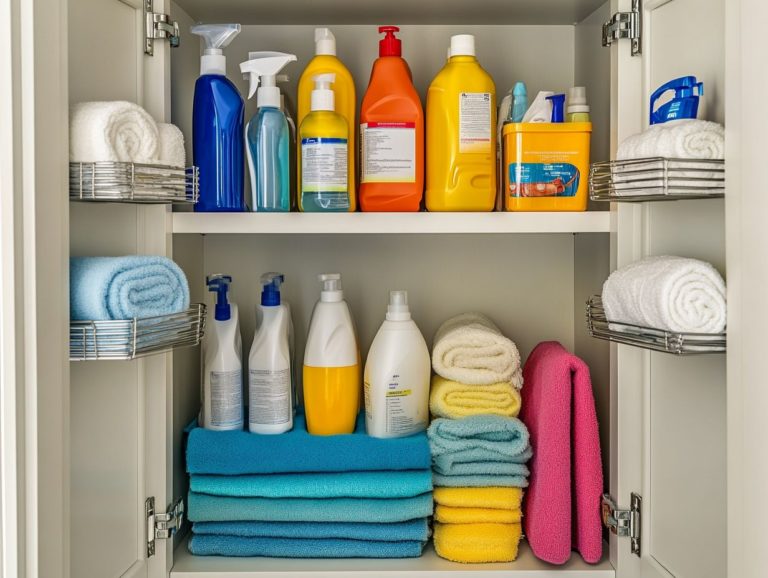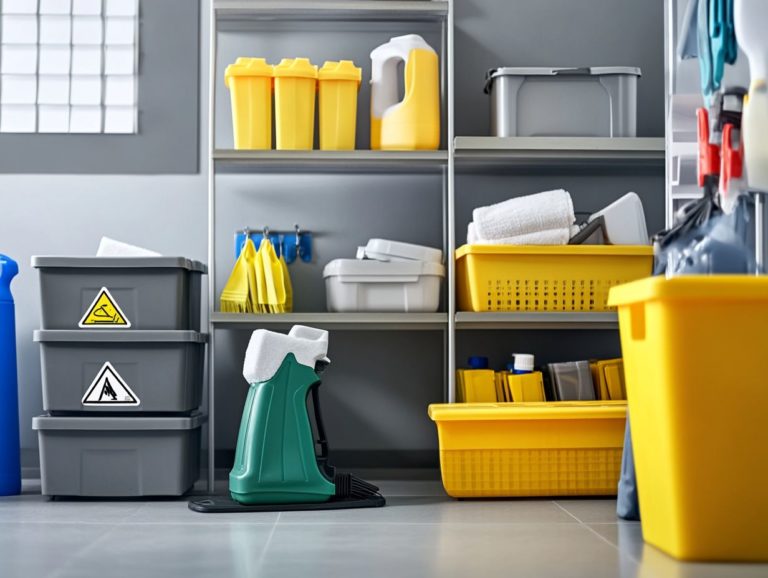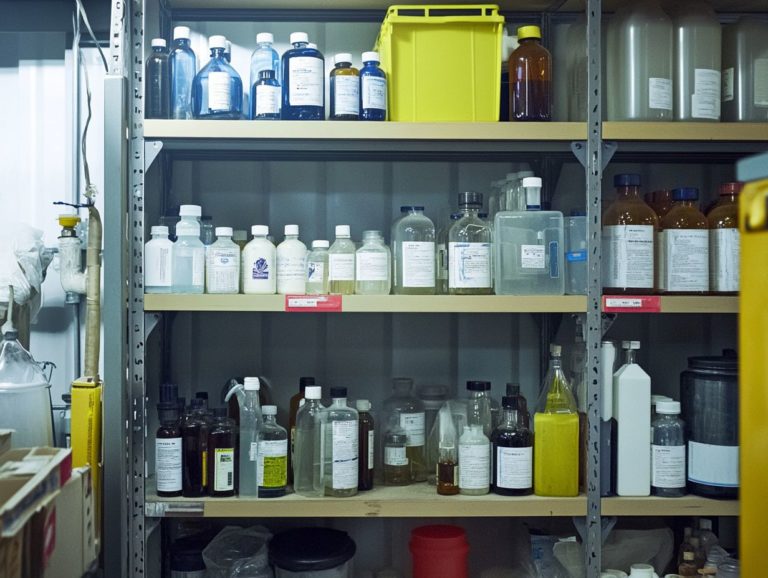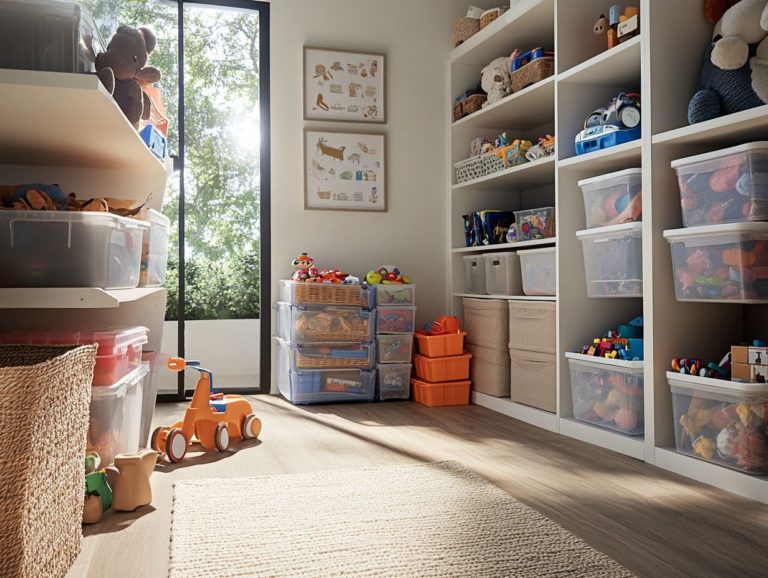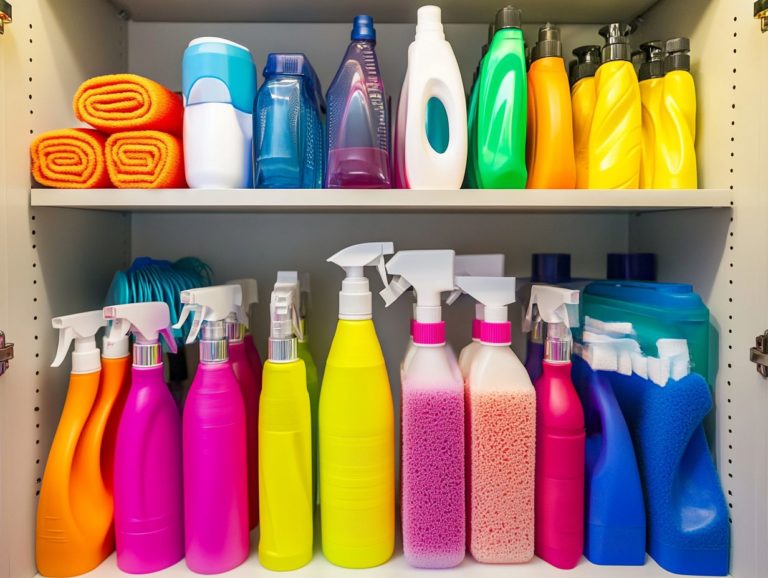Best Ways to Prevent Accidental Mixing
Accidental mixing is a surprisingly prevalent issue that can lead to hazardous consequences, whether at home, during food preparation, or in the workplace.
Grasping what accidental mixing entails and acknowledging its potential risks is essential for maintaining safety in your daily life. This article delves into the various scenarios where accidental mixing frequently occurs, such as with household cleaning products, medications, and chemicals, including art supplies and food safety.
It outlines effective prevention strategies and provides guidance on the steps to take if an accidental mix-up occurs. Safeguarding yourself and your loved ones begins with knowledge continue reading to discover how to avoid accidents and stay safe.
Contents
- Key Takeaways:
- What Is Accidental Mixing?
- Why Is It Important to Prevent Accidental Mixing?
- What Are the Most Common Accidental Mixing Scenarios?
- How Can Accidental Mixing Be Prevented?
- What Are the Risks of Accidental Mixing?
- What Should You Do If Accidental Mixing Occurs?
- Frequently Asked Questions
- What are the best ways to prevent accidental mixing?
- How does labeling help prevent accidental mixing?
- Why is it important to store chemicals in a designated area?
- What safety protocols should be followed when handling chemicals?
- Can improper storage contribute to accidental mixing?
- What should I do if accidental mixing does occur?
Key Takeaways:
What Is Accidental Mixing?
Accidental mixing occurs when different household products, like cleaning supplies, chemicals, and medicines, are unintentionally combined, potentially resulting in hazardous reactions or health risks, especially for children and vulnerable individuals.
Many people aren t aware of how to handle, store, or label these items properly, which makes the issue worse. This lack of awareness can lead to serious safety concerns.
Many household cleaners harbor chemicals that, when mixed, can release harmful fumes, creating a serious safety concern within the home. Grasping the concept of accidental mixing is essential for you to establish effective safety protocols and prevention strategies, including poison prevention measures.
Why Is It Important to Prevent Accidental Mixing?
Preventing accidental mixing is essential for safeguarding the well-being of everyone in your home, especially children. The repercussions of such mixing can be severe, leading to toxic exposures, significant health concerns, or even tragic outcomes.
Therefore, it is imperative to approach safety measures and poison prevention with the utmost seriousness. If your household employs cleaning products, medications, or other hazardous materials like art supplies, it’s crucial to recognize that improper handling can result in dangerous chemical reactions.
By increasing awareness and providing education, including training employees in workplaces, you can effectively reduce risks and ensure a proper response in the event of accidental mixing.
What Are the Most Common Accidental Mixing Scenarios?
Accidental mixing scenarios frequently occur due to routine household practices involving cleaning products, medications, and various chemicals. These situations can result in dangerous consequences, particularly when one mixes common household cleaners like bleach and ammonia, or unintentionally combines different medications or cleaning chemicals without fully grasping their interactions.
Inadequate ventilation while using strong-smelling products can increase health risks from harmful vapors. Recognizing these prevalent scenarios is essential for implementing effective safety management and prevention strategies, including emergency response plans.
Stay informed and take action today to keep your home safe from accidental mixing!
1. Household Cleaning Products
Household cleaning products often top the list of accidental mixing incidents. Many contain potent chemicals that can generate toxic fumes or harmful reactions when combined. You might not realize it, but mixing items like bleach, ammonia, and various surface cleaners can lead to the creation of dangerous gases, posing significant health risks, especially to children.
For example, when bleach meets ammonia, it produces toxic gas, which can be detrimental and potentially result in serious respiratory issues. It’s crucial to understand the properties of these cleaners and adhere to safety measures to avoid skin contact.
Consider this: when you combine a toilet bowl cleaner containing hydrochloric acid with bleach, you unleash chlorine gas. This highly toxic substance can cause eye irritation, throat discomfort, and a range of acute health concerns. It’s important to read labels carefully and avoid mixing cleaners that contain bleach or acidic components. In case of exposure, contact a healthcare provider immediately.
To minimize exposure risks, adopt proper storage practices. Keep hazardous materials in locked cabinets and ensure good ventilation during cleaning sessions. Look for safer alternatives to protect your health while still effectively maintaining a pristine home.
By being aware of these chemical interactions, you can establish safer cleaning routines and foster a healthier living environment. Ultimately, this protects children s safety. Act now to create a safer home!
2. Medications
Medications can pose a significant risk when it comes to accidental mixing. If you unknowingly combine multiple drugs without a clear understanding of their potential interactions, it can lead to adverse effects, such as toxicity or decreased effectiveness. This risk is particularly heightened in households with children, who might gain access to adult medications.
Mixing medications with alcohol can result in severe consequences. It s crucial to follow dosing instructions and seek advice from a healthcare provider.
Implementing safety protocols like secure storage and proper labeling of medicines is absolutely critical for preventing accidental mixing. This ensures that everyone in your household can identify and steer clear of dangerous combinations.
Common examples of medications that are often misused or mistakenly combined include:
- Over-the-counter pain relievers like acetaminophen and ibuprofen, which can be harmful when taken together in excessive doses.
- Mixing anxiety medications, such as benzodiazepines, with alcohol, which can lead to severe respiratory depression.
It s essential to follow the dosing instructions on product labels and pay close attention to any warnings regarding interactions with other products. If accidental ingestion occurs, contact Poison Help immediately.
Practicing safe medication storage such as keeping them in locked cabinets or out of children’s reach significantly reduces the risk of accidental ingestion. By understanding these guidelines and being mindful of medication interactions, you can create a safer environment for yourself and your loved ones. Take action to ensure your family’s safety!
3. Chemicals
Household products, including art supplies, can be dangerous when mixed. For example, mixing acids with bases can cause violent reactions, while combining different cleaning solutions may create harmful compounds.
To reduce the risk of accidental mixing, use safety practices like wearing personal protective equipment and ensuring good ventilation. Properly storing products and following their labels can also help avoid mishaps.
Some combinations, like bleach and ammonia, release toxic vapors that can harm your lungs. Mixing drain cleaners can produce dangerous gases, so understanding these risks is crucial for safety.
Homeowners and caretakers need to be aware of these chemical risks. This awareness fosters a safer environment for everyone.
How Can Accidental Mixing Be Prevented?
Preventing accidental mixing requires clear labeling, effective storage, and following safety tips.
Keep all household products in their original containers with clear labels. This helps everyone identify potential hazards easily. It’s especially important to store products safely to protect children.
Implement these proactive measures to significantly reduce safety incidents. Ensure food is stored properly and never mix food with household chemicals.
1. Proper Labeling and Storage
Properly labeling and storing household products prevents accidental mixing. This ensures that everyone, especially children, can identify hazardous materials.
Each product should stay in its original container, which provides important safety information. This applies to art supplies and other items children may use.
Labels should clearly state the product s purpose, hazards, and safety precautions. Consider using color-coded labels for easy identification of safe versus hazardous substances.
To avoid confusion, keep cleaning supplies organized with labeled bins or sections. Use locking cabinets for dangerous items to promote safety and encourage responsibility. Always have the Poison Help Line and emergency numbers readily available.
2. Separate Storage Areas
Creating separate storage areas for different types of household products is a smart approach to preventing accidental mixing. This significantly lowers the chances of products that shouldn’t be mixed and cleaning chemicals being stored together.
By designating specific zones for cleaning products, medications, and hazardous materials, you ensure that these items remain organized and easily accessible, all without the risk of a dangerous combination. In homes with children, this approach is essential to keep them safe from potential dangers, as secure storage plays a vital role in preventing exposure to toxic substances and poisonous plants.
Establishing designated spaces offers a clearer overview of what you have available and reduces the risk of misplacing essential items, including art supplies and food. For instance, keeping cleaning supplies in a high, locked cabinet can effectively deter curious little hands, while medications deserve a separate area that is both secure and out of reach think a bathroom cupboard fitted with childproof locks.
Hazardous materials, such as paints, solvents, and other chemicals, should be stored in well-labeled bins, ideally in a climate-controlled environment to preserve their quality and safety. This thoughtful organization enhances accessibility and is fundamental in promoting a safe home environment.
Knowing where each product is located minimizes the risk of mishaps and harmful vapors.
3. Follow Instructions and Warnings
Following the instructions and warnings on product labels is crucial for maintaining safety in your household and preventing the accidental mixing of products and chemicals. Each household product comes with specific guidelines regarding its use, storage, and possible dangers.
Adhering to these guidelines is essential to mitigate the risks associated with chemical interactions and food safety. By making these safety tips a priority, you cultivate a safer environment, significantly reducing the chances of poisoning and harmful accidents at home.
Understanding product labels is not just about safety; it s also key to achieving the desired results from your household products. For example, the well-known warning against mixing bleach with ammonia doing so can create a dangerous gas that poses serious health risks.
To ensure compliance with these instructions, always read the labels before use. Look for any symbols indicating hazards and follow the recommended procedures for disposal or storage. Keeping products in their original containers is another important step to prevent dangerous mix-ups.
By taking these precautions, you can enjoy a well-managed household while minimizing potential hazards and avoiding accidents.
4. Dispose of Unused Products Properly
Proper disposal of unused or expired products is crucial for preventing accidental mixing and ensuring a safe home environment. Many household products, especially chemicals, household cleaners, and medicines, can turn hazardous when stored for too long or when they re no longer needed.
It s essential to familiarize yourself with the specific disposal guidelines for various materials, such as batteries, paints, pharmaceuticals, and cleaning equipment. Unused medicines should be returned to a pharmacy take-back program, while chemicals can often be disposed of at local hazardous waste collection events.
By actively engaging in these disposal practices, you not only protect your family and pets from potential exposure to dangerous substances but also contribute to a healthier environment. Prioritizing proper disposal methods helps you prevent safety incidents and ensures that materials are managed in an environmentally responsible way.
What Are the Risks of Accidental Mixing?
The risks of accidental mixing can lead to serious consequences, including exposure to toxic fumes, chemical burns, allergic reactions, and unsafe food preparation.
When household products are combined incorrectly, they can release harmful vapors or create caustic substances that significantly jeopardize personal safety.
This concern is especially pertinent in homes with children, where the chances of exposure to these health risks highlight the urgent necessity for effective prevention strategies. A keen understanding of the dangers lurking in the combination of chemicals and cleaning products is essential.
1. Toxic Fumes
Toxic fumes are among the most immediate threats you face when accidentally mixing household cleaners, especially those containing bleach or ammonia. These common cleaners can react to create hazardous gases that may lead to respiratory issues, eye irritation, and serious health complications.
For instance, mixing bleach with ammonia produces chloramine vapors, which can be especially dangerous in poorly ventilated spaces. You must take preventative measures to understand and avoid these combinations to maintain a safe household environment.
The interaction between vinegar and baking soda releases carbon dioxide, which can cause pressure to build in closed containers. Mixing certain cleaners can also unleash toxic gases that can harm your health. These fumes present serious risks, especially for children and individuals with pre-existing respiratory conditions.
To reduce these dangers, ensure adequate ventilation while using household products. Open windows or turn on exhaust fans to keep the air flowing, and wash your hands thoroughly after handling them. Familiarize yourself with product labels and follow safety guidelines to significantly reduce the likelihood of hazardous chemical reactions.
2. Chemical Burns
Chemical burns pose a significant risk when accidental mixing occurs, especially with substances that can damage skin. These burns can result from direct contact with skin or mucous membranes, leading to pain, injury, and sometimes the need for medical intervention.
Common culprits include bleach, drain cleaners, and certain disinfectants. These products contain potent chemicals that can react explosively. Substances with acids or alkalis are particularly hazardous, creating risks not only when mixed but also when used independently without proper caution.
Always read product labels carefully, wear protective gear like gloves and goggles, and ensure proper ventilation when using strong substances. Implementing a comprehensive household safety plan outlining emergency procedures is crucial for cultivating an environment where everyone knows how to handle products responsibly.
3. Allergic Reactions
Accidental mixing of household products can trigger allergic reactions in sensitive individuals, particularly when products containing allergens are combined. Reactions can range from mild skin irritation to severe respiratory distress, depending on sensitivity and the chemicals involved. You must know what s in your cleaning products to stay safe!
For example, mixing bleach and ammonia common staples in many homes can produce toxic gases that worsen respiratory issues. Additionally, some detergents contain fragrances or preservatives that can provoke allergies or asthma in susceptible individuals.
Carefully read labels and familiarize yourself with the ingredients in your products. This knowledge can help you avoid dangerous products. By practicing safe storage methods like keeping allergens out of reach or in clearly labeled containers you can significantly reduce the risk of accidental mixing.
What Should You Do If Accidental Mixing Occurs?
If accidental mixing occurs, taking immediate action is essential to mitigate health risks and safeguard your personal safety. Your first step is to seek medical attention if you experience any adverse symptoms, such as difficulty breathing or skin irritation.
To further protect yourself, ventilate the area by opening windows or using fans to disperse any toxic fumes. This helps ensure that others are not exposed to this hazardous environment and minimizes carbon monoxide buildup. Familiarizing yourself with the appropriate emergency response in such situations can greatly reduce the potential dangers associated with accidental mixing.
1. Seek Medical Attention
Seeking medical attention is crucial if you suspect accidental mixing has occurred, especially if you notice symptoms of poisoning or harmful reactions. Call the Poison Help Line for quick advice. Symptoms may include difficult breathing, nausea, vomiting, or skin irritation. All of these demand immediate medical evaluation and treatment from a health care provider.
Act now! Households must establish clear protocols for accessing poison help or contacting emergency services to ensure a swift response to any health risks associated with accidental mixing. Always have an emergency phone ready.
Spotting these warning signs is crucial, as many people may not immediately connect their symptoms to exposure to toxic substances. Everyone, especially caregivers, must stay alert to the potential dangers that can lurk in everyday household products, including cleaning products, medicines, and art supplies.
Be prepared! Know your local emergency numbers and keep them handy. This includes knowing the location of the nearest medical facility, keeping a well-stocked first aid kit ready, and being able to relay information effectively to health care providers or Poison Help centers.
Make sure everyone knows how to contact the Poison Help Line and recognize when to seek immediate assistance. Educating family members about the necessary steps when symptoms arise can significantly improve outcomes, ensuring that those affected receive timely and appropriate care.
2. Ventilate the Area
Ventilating the area is essential to reduce risks associated with mixing chemicals. By dispersing harmful vapors, you dramatically improve the environment. Opening windows and doors, or using fans, can enhance air circulation, reducing the concentration of toxic fumes and elevating overall air quality. This becomes particularly crucial in enclosed spaces where chemical reactions might have released dangerous gases, ensuring the health and safety of everyone nearby.
To elevate ventilation further, consider positioning exhaust fans strategically to draw out contaminated air while letting in fresh air from outside. Use a cross-ventilation strategy, which is opening doors on opposite sides of a room to let fresh air in, to maximize airflow efficiency. It s also vital to take precautions, such as wearing personal protective equipment like respirators and gloves while implementing these ventilation measures, to minimize your exposure to harmful substances.
Regularly monitoring air quality should be part of your routine to assess the effectiveness of these actions, ensuring a safe environment in the aftermath of any incident. By implementing these methods, you play a crucial role in safeguarding public health following accidental chemical mixing and mitigating health risks associated with harmful vapors.
3. Follow Instructions on the Product Label
Following the instructions on the product label is essential after an accidental mixing. These guidelines provide vital information for managing the situation safely.
Many products include specific recommendations for handling accidental exposure or mixing. They also detail first aid measures and emergency contacts.
By following these instructions, you can respond effectively and reduce health risks from chemical interactions.
Understanding labels means recognizing key safety symbols and warning signs. For instance, a label might say to rinse with water immediately if contact with skin occurs, or to call a poison control center if ingested.
These precautionary statements are invaluable. They help prevent serious health issues and provide peace of mind during emergencies.
Some products even recommend wearing safety gear, like gloves and masks. This ensures safe handling.
Pay close attention to product labels. Your safety and that of those around you depends on it. This includes proper storage of chemicals in their original containers and following food safety guidelines.
Frequently Asked Questions
What are the best ways to prevent accidental mixing?
Label all containers clearly and store chemicals in a designated area. Follow safety protocols when handling them.
How does labeling help prevent accidental mixing?
Clear labels show the chemical name and necessary safety information. This avoids confusion and prevents mixing incompatible chemicals.
Why is it important to store chemicals in a designated area?
Storing chemicals apart from other materials prevents accidental mixing. It also helps keep track of what s being used.
What safety protocols should be followed when handling chemicals?
Wear appropriate safety gear and work in a well-ventilated area. Always read and follow safety instructions from the manufacturer.
Can improper storage contribute to accidental mixing?
Yes, improper storage makes it hard to keep track of chemicals. It can also lead to cross-contamination.
What should I do if accidental mixing does occur?
If mixing happens, act fast! Remove yourself and others from the area, ventilate the space, and seek professional help. In some cases, call emergency services.
Check your labels today and stay safe!
